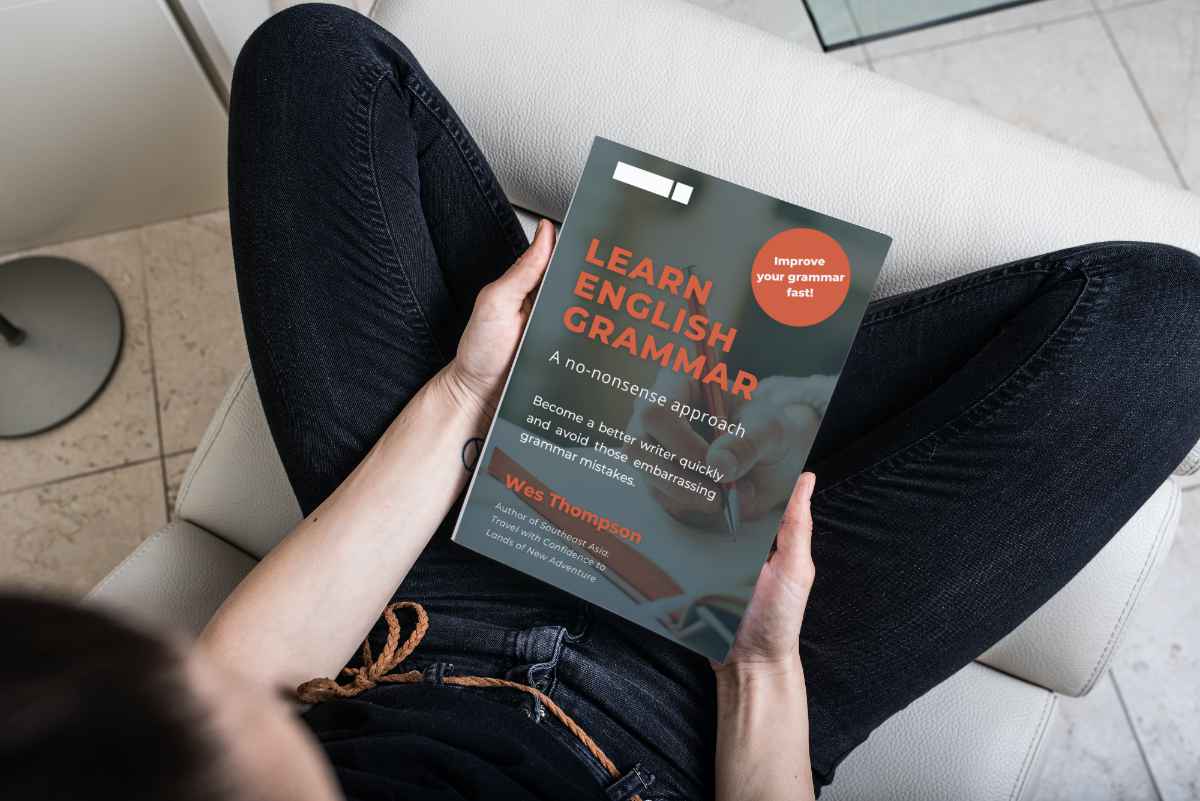Ready to explore how to learn English grammar? Let’s keep making progress and explore some tips that will help you to learn English grammar better.
Whether you’re a newbie or looking to brush up on your skills, exploring how to learn English grammar can be both fun and rewarding. Plus, it’s worth the effort because the result is that you will be a much more effective communicator.
How to Learn English Grammar: The Backbone of Language
Grammar is the structure that holds your sentences together, giving your thoughts clarity and coherence.
By mastering grammar, you’re not just learning rules, you’re also unlocking the key to better communication.
Embrace Your Inner Detective
Learning grammar is like solving language puzzles. Observe how sentences are formed in books, movies, and everyday conversations. When you spot something new, ask yourself: “Why did they use that word order?” “What is that punctuation mark?”
Seeing real-world examples in print will enhance your learning and help you to make even better sense of grammar.
Start with the Basics
Just like a skyscraper needs a solid foundation, your grammar journey begins with the basics. Nail down sentence structure, parts of speech (nouns, verbs, adjectives, etc.), and subject-verb agreement.
Once you’ve got these building blocks, you’ll be ready to construct more complex sentences.
Dive into Tenses
Tenses are your time-travel devices in grammar. They let you navigate through past, present, and future. Start with the simple tenses (present, past, and future) and work your way up to the perfect and continuous tenses.
Soon, you’ll be writing better letters, emails, and blog posts and will be more skillful in using grammar rules.
Learn All About Verbs
Verbs are the engines of your sentences. Understand verb conjugation (changing verbs based on subjects) and verb forms (base form, past, and past participle) to wield your verb usage with confidence.
I ran up the hill and saw a nice view of the city.
The verbs in this sentence are “ran” and “saw” because they show the action (what was done) in the sentence.
Punctuation Power-Up
Punctuation is like the rhythm and melody of your writing. Learn how to use commas, periods, question marks, exclamation points, and more to add clarity to your sentences.
Punctuation marks are an important part of learning to write at a professional level.

Learning English grammar can be fun and rewarding. The more effort you put in the more you will improve.
Navigating Nouns and Pronouns
Nouns are one of the most fundamental parts of a sentence. They may be people (your neighbor), places (London), things (cars and hats), or even ideas (thoughts and dreams).
Pronouns may take the place of nouns later in a sentence. Some examples of pronouns are “he,” “she,” “it,” and “they.” Their possessive forms are “his,” her,” “its,” and “their.”
Adjectives and Adverbs
Adjectives describe nouns, while adverbs describe verbs. Learn how to use these descriptive words to add some interest and life to your writing and speaking.
The sky was blue, and the birds sang cheerfully.
What was the sky (noun) like? It was blue. This is an adjective.
How did the birds sing (verb)? Cheerfully. This is an adjective.
Conjunction Junction
Conjunctions are words that connect two ideas or items in a sentence together, such as “and,” or show how they differ, like “but” or “yet.” Other conjunctions are, for example, “because,” “for,” “with,” and “or.”
I like going swimming and riding my bicycle.
Prepositions and Prepositional Phrases
Prepositions are like roadways in your sentences. They show the paths between words, or another way to think about it, like direction or place words.
The cat is on the table.
We met at the park.
The boy ran toward the ice cream truck.
Master these directional signals to guide your reader through your writing landscape.
More Advanced Considerations
As you journey deeper into the realm of English grammar, there are a few advanced techniques and stylistic tips that will truly set you apart as a better writer.
Parallel Structure
Just as you have to match your outfit, everything in your writing also needs to be in sync. When listing items or ideas, make sure they follow the same grammatical structure.
I like hiking, swimming, and to read.
This sentence is not in parallel. Let’s fix that:
I like hiking, swimming, and reading.
Now, do you notice that all three verbs end in “-ing”? Well, that is called the progressive tense and having all three verbs in the same tense makes the sentence have a parallel structure.
Dangling Modifiers
These grammar errors can sometimes lead to hilarious or confusing sentences. Make sure your modifiers are placed next to the words they’re supposed to modify.
Running in the park, my shoes got soaked.”
Wait, did your shoes run in the park? Let’s fix it: “While I was running in the park, my shoes got soaked.”
Clauses and Complex Sentences
Elevate your writing by mastering different types of clauses, such as independent, dependent, adjective, and adverb clauses. Combine them to create complex sentences that add depth and variety to your writing.
The part of the sentence that could be a separate sentence is the independent clause.
While waiting for his mother, the boy completed his homework.
In the sentence above, which is the dependent clause and which is independent? “While waiting for his mother” is the dependent clause. This part of the sentence could not be a sentence on its own. It is dependent on the rest of the sentence to make a complete sentence.
However, “the boy completed his homework” is indeed a complete sentence. Therefore, it is the independent clause.
Voice and Mood
Discover the magical world of active and passive voice, and how they impact the mood and tone of your writing.
The chef prepared the meal (active voice) versus The meal was prepared by the chef (passive voice).
Colons, Semi-Colons and Em-Dashes
Colons are used to indicate that a list of items will follow.
I am able to offer the following: web design, copy writing, proofreading, and editing.
We are open on these days of the week: Monday, Wednesdays, and Saturdays.
Once you’re comfortable with colons, venture into the world of semi-colons and em-dashes. Semi-colons connect related independent clauses; em-dashes add emphasis or set off a phrase.
It’s really quite simple; we need to spend less on travel and utilities. A semi-colon is ideal when you want to join two shorter sentences that closely relate to each other.
Em-dashes may also serve in place of commas to set information apart.
Choose one of the options on the menu — chicken, fish, or pork — and inform your server of your preference.
Subjunctive Mood
Ever wish for something that isn’t true? That’s the subjunctive mood.
If I were a bird, I would fly” (not “was”).
It may not be intuitive, but it’s the proper way to express wishes.
Cohesion and Flow
Transition words and phrases are your best friends for smooth and logical writing. Use words like “however,” “therefore,” “in addition,” and “on the other hand” to guide your reader through your ideas.
I like to visit France; however, I would love to see Spain one day as well.
Idioms and Figurative Language
Sprinkle some idioms and metaphors into your writing to add flavor and flair.
She’s as busy as a bee or His words were music to her ears.
Consistency in Style
Whether you’re using American or British English, formal or informal language, stay consistent throughout your writing to create a polished and professional piece.
Just like a sculptor perfects his or her masterpiece, review your work for grammar errors, typos, and clarity.
Proofreading and Editing: Just like a sculptor perfects their masterpiece, review your work for grammar errors, typos, and clarity. A well-edited piece shines like a diamond.
Sentence Variety
It’s great to be creative and use a variety of sentence types in your writing: simple, compound, complex, and compound-complex. Mix them up to keep your writing engaging and dynamic.
Connotation and Denotation
Words carry baggage, whether positive, negative, or neutral. Dive into the world of connotation (emotional association) and denotation (literal meaning) to add layers of meaning to your writing.
Stylistic Devices
Explore literary devices like alliteration, metaphor, simile, and personification to infuse your writing with vivid imagery and creative expression.
The stars danced in the velvet sky.
Rhetorical Techniques
Delve into the art of persuasion by mastering techniques like ethos, pathos, and logos. Use these tools to create compelling arguments and persuasive essays.
Sentence Cohesion
Take your sentence flow to the next level by using cohesive devices like pronouns, repetition, and transitional expressions. Your writing will be a better harmony of interconnected ideas.
Subordination and Coordination
Elevate your sentence structures by incorporating subordinate and coordinate clauses. This adds depth and sophistication to your writing.
Precise Vocabulary
Expand your vocabulary by learning synonyms, antonyms, and shades of meaning. Find the perfect word to capture the essence of your ideas.
Contextual Usage
Context matters! Understand how words change meaning based on the context in which they’re used.
That’s sick!
Is it a compliment or concern?
Elegance in Editing
Be sure to polish your writing through thorough editing. Pay attention to conciseness, clarity, and coherence to make your writing shine.
Genre-Specific Grammar
Different genres have different grammar rules. Dive into the grammar nuances of creative writing, academic essays, business communication, and more.
Practice Makes Perfect
Your grammar will get better with practice. Write daily, engage in grammar exercises, and play with different sentence structures. The more you practice, the more you’ll internalize the rules.
Take an Online Course
There are a number of online grammar courses available at all levels, beginner, intermediate, and advanced. Coursera is one example. LinkedIn Learning offers a variety of courses as well.
The advantage of online courses is that you can repeat the lessons as often as you need and refresh your memory. You can usually preview a course before making a purchase.
Play Grammar Games
Who said learning grammar had to be boring? Dive into some grammar games that make learning feel like playtime:
1. Grammar Quizzes: Online quizzes are like brain workouts. They challenge your grammar skills and provide instant feedback.
2. Mad Libs: These fill-in-the-blank stories are fun. They help you practice different parts of speech in a creative way.
3. Grammar Apps: There’s an app for everything, including grammar! Explore apps that turn learning into a game.
4. Sentence Diagramming: It’s like grammar Sudoku. Break down sentences into their parts and see how they fit together.
5. Grammarly Adventures: Use tools like Grammarly to catch your grammar slip-ups while you’re writing emails, social media posts, and more.
How to Learn English Grammar: Your Language Odyssey Awaits

Learning grammar takes time and patience. But with every new rule that you learn, you’re enabling yourself to improve your communication skills.
Remember, grammar is your ally, not your adversary. Don’t be afraid to make mistakes; they’re the stepping stones to mastery.
As you learn more about verbs, nouns, and punctuation marks, know that you’re creating a solid foundation for confident and effective communication.
Remember, grammar is your ally, not your adversary. Don’t be afraid to make mistakes; they’re the stepping stones to mastery.
Happy learning, and may your grammar adventure be filled with excitement, discovery, and a whole lot of language magic.
If you would like to learn English grammar through a video course, I offer one on Udemy. If you prefer to learn by reading, I also have a book, Learn English Grammar, available on Amazon. Please take a look!
Wes is a certified English teacher and school administrator. He has taught English literature, reading, and writing to students from grade 8 to older adult since 1998. He has taught both native speakers of English as well as English-language learners.
Please send Wes a message here and he will reply within 12 hours.
You can learn more about Wes here.



